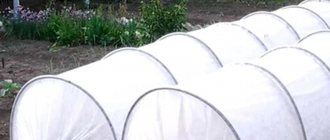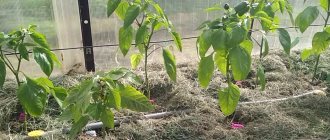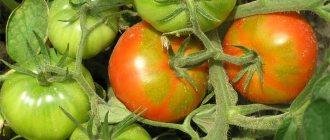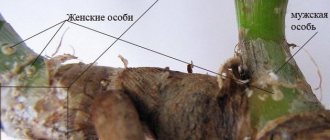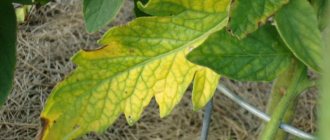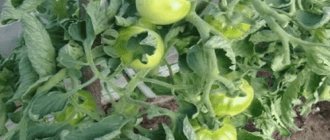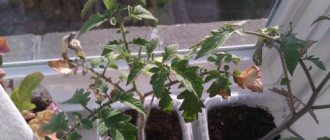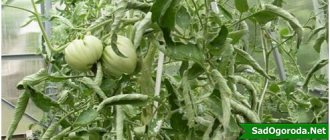Any change in the color of tomato seedlings signals a deviation from the norm and should cause concern among gardeners. The cause must be identified, classified and corrected as quickly as possible. Why tomato seedlings have purple leaves is a question that worries only beginning gardeners.
Experienced people have probably encountered this problem, many more than once, and they know how to deal with it. But some people think there's nothing to worry about. And the complications that arise later are in no way connected with the fact that at an early stage of development the tomato leaves acquired a purple tint.
Reason one: unsuitable soil
Normal tomato development occurs when the soil contains sufficient amounts of essential nutrients. If there are not enough of them, growth slows down. Therefore, before planting tomato seedlings, it is fertilized.
The purple lower part of the leaves indicates unfavorable environmental conditions or a lack of micronutrients in the soil, especially phosphorus. Under such conditions, the plant strives to provide the deficient element to young tissues, while infringing on the rest.
Similar consequences for tomato seedlings occur in soil with an acidic or alkaline reaction. Phosphorus, even if there is enough of it, is poorly accessible to tomatoes and is almost not absorbed by them.
What are the risks of phosphorus deficiency?
Phosphorus is one of the main nutrients that gives plants, including tomatoes, energy. Its deficiency, signaled by the purple or blue-red color of the leaves, is especially dangerous in the initial stages of development:
- a weak or underdeveloped root system is formed;
- resistance to stress factors decreases;
- resistance to diseases decreases;
- all processes occurring in the plant are disrupted - metabolic processes, photosynthesis, vegetative organs and fruits are not formed correctly;
- the growth and development of tomatoes is inhibited;
- the harvest is much less than stated in the variety description;
- the quality of the fruit decreases.
The consequences of phosphorus starvation at an early age in tomatoes cannot be completely corrected after transplanting into a greenhouse or soil.
Rules of agricultural technology for growing tomatoes
Whatever the reason for purple leaves on tomatoes, it is a consequence of the vegetable grower’s mistakes, ignorance or non-compliance with agricultural practices. To avoid problems, the gardener must know what soil is suitable for tomatoes, what air temperature, lighting is most comfortable for seedlings, and how much fertilizer is applied.
The soil
Ready-made universal soil for vegetable crops is suitable for growing seedlings. Its composition is balanced, there are enough nutrients for the normal development of plants before the first feeding. When preparing the soil yourself for sowing seeds, the substrate should be loose, fertile, and light.
Temperature and light
It is recommended to maintain the room temperature before germination at about 25 degrees C, after germination - up to 20 degrees C during the day, and up to 16 degrees C at night. If a purple tint appears, the vegetable seedlings are placed in a warmer place and the color is restored.
Tomato seedlings should be placed on the brightest windowsill. If the lack of natural light has caused them to stretch, you can remove the lower leaves, sprinkle the stem with soil, and lower the air temperature. If there is a lack of sunlight during the initial period of growth, the seedlings are illuminated in the morning and evening with phytolamps so that the daylight hours are 10–12 hours.
Micronutrient supplementation
The cessation of seedling growth and the appearance of a purple color indicate that it is time to fertilize. To replenish phosphorus reserves, the soil is watered with an aqueous solution of nitrophoska, nitroammophosphate, superphosphate.
Using wood ash gives the same result if it is sprinkled on the surface of the soil or poured with an aqueous solution. For foliar spraying, prepare a solution of hot water and ash, taken in equal volumes of 1 liter. After infusing for a day, the mixture is diluted with 3 liters of warm water with 15 g of laundry soap. The plants are sprayed with the resulting solution.
Bone meal contains a lot of phosphorus. It is also used as fertilizer, sprinkling each square meter of soil with 100 g of flour.
Growth stimulants (Zircon, Epin, Kornevin and others) are used to quickly restore tomatoes.
The purple tint on tomato plants is not considered a serious problem and can be quickly resolved by eliminating the causes that caused its appearance.
Treatment of phosphorus starvation
If the seedlings turn purple, first of all you need to adjust the temperature, and then think about what to feed. Excess fertilizer is no less dangerous than too little.
Temperature increase
If the seedlings turn purple and the leaves are raised up, the reason is definitely the low temperature. When it is adjusted, the color of the vegetative organs will return to normal.
Sometimes, in order for leaves that are purple underneath to regain their natural color, you only need to raise the temperature a few degrees. For this it is enough:
- move the box with tomatoes 5-10 cm away from the window, or at least so that the leaves do not touch the glass;
- if the seedlings are illuminated by a table lamp, lower it a little;
- place foil between the glass and the seedling containers;
- regularly rotate the box relative to the window;
- in the greenhouse you can place purple tomatoes higher up - it’s always a little warmer there.
If the room gets very cold at night, for example, the temperature depends on the firewood thrown into the stove, covering the seedlings with old blankets or outerwear will help preserve the heat.
Feeding
Only if the increase in temperature does not help, or the owners know that the tomatoes that have turned purple definitely do not have enough phosphorus, can they start fertilizing. In this particular case, all drugs containing the element are divided into two groups:
- phosphorus acts immediately;
- the macronutrient must be made easily accessible to tomatoes.
Among the drugs ready for immediate use:
- potassium sulfate or potassium sulfate for fertilizing the soil;
- magnesium sulfate for spraying;
- Potassium monophosphate works well under the root and on the leaf.
But these drugs work at temperatures above 15° C. What to do if the tomatoes are purple, they clearly lack phosphorus, and there is no way to increase the temperature? In this case, it is good to have the new Israeli drug Picoside on hand. It saturates plants with P even at low temperatures.
The phosphorus contained in fertilizers such as superphosphate, dolomite flour, azophosphate, etc. can be made readily available to plants in different ways. The simplest is to pour a tablespoon of the drug into a glass of boiling water, cover with a lid, and let it brew for at least 8 hours. Dilute with water to 2 liters and water the seedlings.
Blue-green tint only below
This is a sign of a lack of nutrients:
- magnesium;
- potassium;
- nitrogen;
- zinc
Lack of components slows down growth and reduces yield. Deficiency can be determined by the tops. Usually the purple color on the bottom of the leaf appears due to a lack of phosphorus.
If this problem occurs, you need to spray the leaves with water-soluble superphosphate. The procedure is carried out in the morning or evening, when there are no bright rays of the sun.
We invite you to watch a video on how to help tomatoes whose bottom part of the leaf has turned blue:
Purple stem
It appears when there is an overdose of manganese, which is used to disinfect soil. Sometimes this is a feature of the variety or hybrid. Another purple stem appears when there is a lack of phosphorus.
The deficiency can be eliminated by spraying with water-soluble superphosphate. The solution should have a concentration of 1%. Spraying is carried out in the morning or evening, when there is no bright sun.
Purple spots over the entire surface of the plate
Purple leaves are not the norm. The reason may be unsuitable soil, lack of light, temperature violations, or phosphorus deficiency. But this usually happens when the soil is unbalanced. Whatever the reason, this leads to the plant having a diseased appearance. You should not expect a rich harvest from such plants.
If purple spots appear, it is advisable to spray them with water-soluble superphosphate. The procedure should be carried out in the morning or evening, when there is no strong exposure to the sun's rays.
Sulfur deficiency
Sulfur, unlike phosphorus, is easily absorbed and enters plants even from the air. But it would be wrong to ignore her deficiency about changing the color of tomatoes to purple.
The blue color on vegetative organs due to a lack of S usually appears not on seedlings, but on adult tomatoes growing in a greenhouse, or on seedlings ready to move into the ground. The stems, veins and petioles turn purple first. The lower leaves turn yellow, the upper leaves remain green, but become smaller and curl.
Gardeners do not always distinguish between S and P deficiency, especially since they most often use superphosphate extract to combat purple leaves. The drug, as a ballast substance, contains sulfur in an amount that is sufficient to compensate for the deficiency of the microelement. So it turns out that we fought against the lack of phosphorus, at the same time fed it with sulfur, and the tomatoes returned to normal.
Advice from experienced agronomists
Effective measures will help prevent problems when growing tomatoes:
- Soil made from humus, peat, garden soil and river sand helps. This is a balanced mixture.
- Moisture-loving tomato varieties are negatively affected by foliar watering. Roots require moisture.
- The quality of illumination depends on the density of plantings. There should be a distance of 1.5–2 cm between the seedlings. Then they are picked, transplanted into separate pots.
- Light should be maintained for 12 hours.
- Timely fertilizers will help prevent starvation.
If the leaves and stems of tomatoes turn purple, the reasons usually lie in violation of the growing rules. Nutrition deficiency, improper lighting, unsuitable soil and low temperatures are the main factors that change the color of green mass. When a problem arises, it is important to take effective measures in a timely manner. It’s even better to prevent this from happening through prevention.
Leaves change color and curl
This occurs when there is a nutritional imbalance. The color and shape of the leaves change, and deformation is observed. Such signs appear both with an excess and with a deficiency of microelements. This is not the norm, so timely help is important.
It is necessary to develop a suitable nutrition system in which all the necessary elements will be introduced during watering. Some valuable components are added with fertilizers. Timely help consists of fertilizing with organic matter and stove ash.
Fighting methods
Once a symptom is identified, measures must be taken immediately to preserve the harvest . It is important to correctly identify the source of the problem so as not to destroy the plants. Purple spots are not treated with medications; this problem is caused by care errors. The situation can be corrected by increasing the temperature and adding additional fertilizing.
Maintaining optimal air temperature
Cold has a negative effect on young plants . If seedlings are grown at home, it is necessary to protect them from the penetration of cold air. In greenhouses, all windows and doors are closed, and additional heaters are installed. For irrigation use only warm water. If tomatoes grow in open ground, during cold weather they are covered with additional film material.
Seedlings may turn blue in the first days of hardening . You can start placing pots with plants in the open air at a temperature of +18 °C. Experienced gardeners believe that adaptation to open air can be carried out even at +16 °C - this will make the seedlings more resistant to adverse weather conditions.

